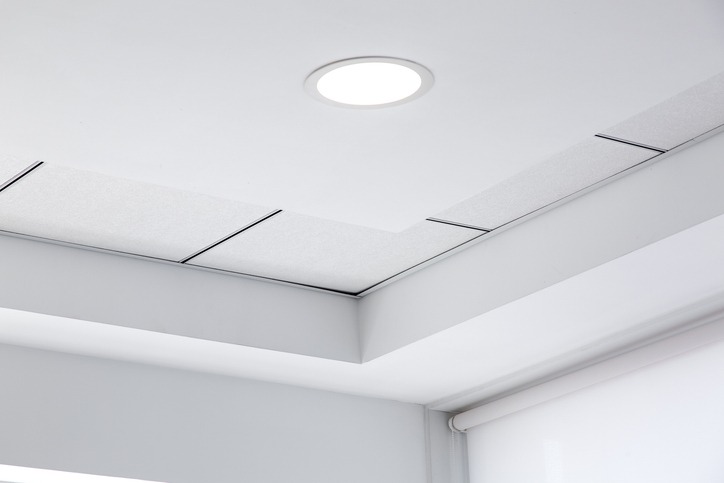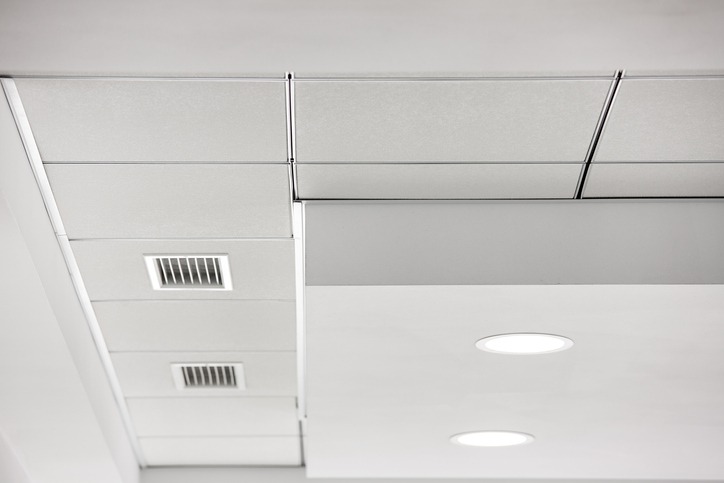A suspended ceiling is also known as drop ceiling. It is a type of finish that is hung just below the main ceiling structure in a room. This means that a suspended ceiling does not make up a permanent structural foundation but rather serves as a covering for the more solid framework above. It is a great type of ceiling if you want to hide the ductwork and pipes in your ceiling, lower your ceiling, or save on utility bills.
Suspended ceilings typically consist of a framework of metal tracks suspended from the main ceiling using wires. Then tiles and panels are laid between the tracks which form the suspended ceiling.
Suspended ceilings come with several benefits and few disadvantages, therefore, if you’re looking into installing a suspended ceiling, we’re here to help you decide if it’s a good decision. Here are the important things you need to know about suspended ceilings.
Types of Suspended Ceilings
Suspended ceilings are known to provide easy access for maintenance and they also come in a variety of styles depending on your needs. Here are some of those styles you can choose from:
Exposed Grid: This is the most common type of suspended ceiling. It includes long metal strips which are called “mains”. These mains are interconnected with shorter metal pieces called “tees”. The mains and tees form a grid system of 2’ by 2’ or 2’ by 4’ squares then these are filled with acoustical ceiling times.
Concealed Grid: In this style of suspended ceiling, it uses acoustical tiles to hid the grid system from view. It will give your ceiling a smooth and clean look which is aesthetically pleasing. However, this style is more expensive compared to the exposed grid style.
Bandraster: This is one of the most versatile styles of suspended ceilings because it is composed of metal tees and mains with different lengths and they can be used in a variety of patterns. This style is usually used to create a certain look with the ceiling because it can be arranged in a lot of ways.
Suspended Drywall Ceilings: This style of suspended ceiling does not use metal grid but wires and hangers instead to suspend sheets of drywall below the ceiling. This is a great and an easier alternative to extensive framing which is typically required to create drywall arches or ceiling structures.
Advantages of Suspended Ceilings
Suspended ceilings come with a lot of advantages. If you’re planning to install a suspended ceiling, here are the things that you may find great about it.
Easy to Install: Suspended ceilings are very easy to install. In fact, people with the required knowledge can buy the materials needed and install the ceiling themselves. But of course, it’s still safer and wiser to consult a licensed contractor for advice about installing suspended ceilings.
Easy to Remove in Case of Repairs: When it comes to renovations, suspended ceilings are also great because their panels can be removed easily for repairs and can be reassembled easily as well after the repairs have been done. Unlike with traditional plaster ceilings where repair work can be expensive and time-consuming because it requires demolishing the ceiling to be able to reach hidden components.
Can Hide Ductwork, Wires, and Pipes: As mentioned earlier, suspended ceilings are great for those who wish to hide ductwork and pipes in your ceiling. You can install a suspended ceiling to cover them as well as stains and peeled paint. Therefore, if you are buying a space with suspended ceilings, it’s also important that you have the panels removed and inspect the space above it to make sure that there are no structural problems.
Can Provide Sound Proofing: Suspended ceilings with fiberglass can block all of the sounds from outside. This is great to install in offices or entertainment rooms to make these spaces much cozier and peaceful.
A Lot of Colors and Materials to Choose From: Suspended ceilings come in different materials such as fiber, plastic, and wood. There are also some panels for suspended ceilings that have an added degree of fire protection, making it a safe choice as well.
Lights Can Be Installed Easily: Another great thing about suspended ceilings is you can install lights to it easily. Aside from lights, you can also easily install fans and other overhead appliances between the panels of a suspended ceiling.
Energy Efficiency: Installing suspended ceilings can lower your ceiling’s height which can provide exceptional insulation This means that it can help you lower your energy bill because there will be less space to heat up.
Design Ideas for Suspended Ceilings
Lighting Integration: One of the most exciting aspects of suspended ceilings is the ability to incorporate various lighting designs directly into the ceiling. From recessed lighting to modern LED panels, the options are virtually endless, allowing for creative and functional lighting solutions.
Texture and Color: Suspended ceiling tiles come in a wide range of textures and colors. You can choose from smooth, sleek finishes to more textured, patterned tiles, depending on the desired look and feel of your space.
Architectural Features: For those looking to add an architectural element, suspended ceilings can be used to create interesting visual features, such as coffers or bulkheads. This adds depth and character to the room.
Material Variety: Materials for suspended ceilings include mineral fiber, metal, plasterboard, and even translucent panels for diffusing light. Each material offers its own set of benefits and aesthetic qualities, allowing for customization according to specific needs and preferences.
Disadvantages of Suspended Ceilings
Suspended ceilings come with a lot of advantages but there are few disadvantages as well. One is it may deteriorate faster. Suspended ceilings are known to not last very long. After a few years of use, they tend to sag and show stains and as well as discoloration. Therefore, frequent maintenance is needed to keep them looking good.
Another disadvantage of suspended ceilings is they are not as sturdy compared to traditional ceilings. This means that in the event of an earthquake, they may be very unstable, plus the danger of the installed fixtures falling. But this can be prevented by regularly checking on the ceiling’s condition and giving it frequent maintenance.
But overall, a suspended ceiling is a really great choice especially for those who want to maintain a tidy look for their ceiling. It is the perfect solution to hide wires and pipes in a clean and stylish way while still providing easy access in case of problems and repairs.
Installation and Maintenance
While suspended ceilings can be a DIY project for those with some construction experience, professional installation is recommended for the best results. Maintenance is relatively simple, with regular cleaning and the occasional replacement of damaged tiles being the main
Final Thoughts
Suspended ceilings offer a versatile and stylish solution for modernizing and enhancing both commercial and residential spaces. With their numerous aesthetic and functional benefits, they provide an effective way to upgrade interiors. Whether you’re looking to improve acoustics, integrate innovative lighting, or simply refresh the look of a room, suspended ceilings can offer a practical and attractive solution.
Incorporating a suspended ceiling into your space can transform it into a more efficient, functional, and visually appealing environment. With a wide range of materials, designs, and applications, the possibilities are endless, allowing you to create a unique space that meets your needs and reflects your style.


